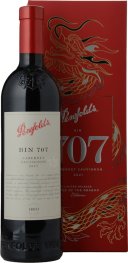Chateau Cos d'Estournel 19
Majestic, intense, full-bodied and tannic, Cos dEstournel is considered the leading wine of St Estèphe. Highly tannic in its youth, over time it develops much much like the great wines of adjoining Pauillac. A true "super second" growth.
Chateau Belair-Monange 1er grand cru classe (B)
Previously known as Chateau Belair, the name was changed to Belair-Monange upon its full purchase by the Moueix family in 2008. The 12 ha vineyard is planted predominately to Merlot with some Cabernet Franc growing on limestone and clay soils. A blend of 85% Merlot and 15% Cabernet Franc, the wine is fermented in stainless steel and lined concrete tanks prior to undergoing maturation in a mix of new and seasoned barriques for 18 months. A philosophy encompassing reduced yields, later harvesting and meticulous fruit selection have resulted in a richer more generous, concentrated style since 2008.
Penfolds Bin 707 Lunar New Year Cork
Chateau Pavie 1Er Grand Cru Classe St-Emilion
Complex aromas of red and black fruit, graphite and black truffle with faint marine influence as it unfolds in a glass. Medium-bodied on the palate with brambly note underneath the core of blueberry, acai and boysenberry fruit. Firm tannin with impressive backbone and loads of licorice, bay, tobacco and black tea flavours fill in through the finish.
Chateau Palmer Historical XIXth Century Blend LOT 20.19 Cabernet Merlot Syrah
Château De Lafite Carruades De Lafite Second Wine Of Chateau Lafite Pauillac
Carruades de Lafite, the second wine of the esteemed Château Lafite Rothschild in Bordeaux, France, exemplifies the winery's commitment to excellence and offers a compelling expression of the Pauillac appellation. Sourced from the same vineyards as its grand vin counterpart, Carruades de Lafite showcases a refined and approachable style, characterized by elegant fruit flavors, harmonious structure, and a notable sense of finesse. While it may not possess the same depth and longevity as the grand vin, it remains a highly regarded and sought-after wine, providing wine enthusiasts with a captivating glimpse into the renowned heritage of Château Lafite Rothschild.
Chateau Pichon-Longueville Baron Lalande Pauillac
"Chateau Pichon-Longueville Comtesse de Lalande is the sister property to Chateau Pichon-Longueville Baron, formed upon the death of Baron Joseph de Pichon Longueville in 1850. The parcel of vines we now know as Pichon Lalande were passed to the Baron’s three daughters, and today is one of the most elegant wines in the Haut Medoc. This elegance should not be confused with being underweight, as the wines have enormous richness and intensity, and age extremely well. Plantings on the large property include a blend of 61% Cabernet Sauvignon, 32% Merlot, 4% Cabernet Franc, and 3% Petit Verdot."
Carruades de Lafite Pauillac
Chateau Lafite Rothschild’s celebrated second wine, Carruades de Lafite is named from plots acquired in 1845 just next to the vines on the Château hilltop and the final blend contains both declassified first growth fruit as well as a higher percentage of Merlot than the first wine, anywhere from 30-50 percent depending on the vintage. As a result, you get the elegance and persistence of Lafite but also a suppleness making it approachable when young but always with enough structure to warrant at least a decade of cellaring.









